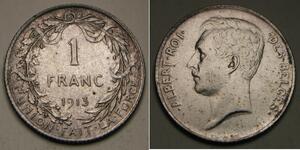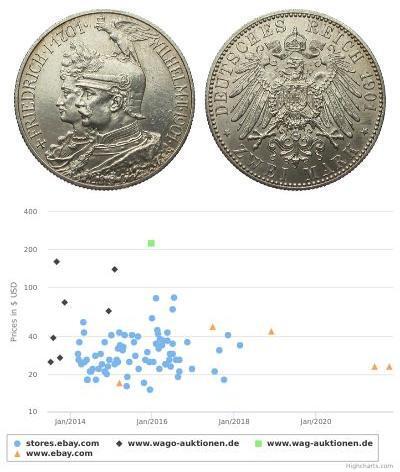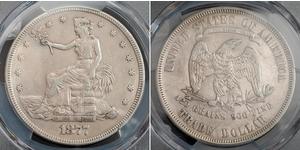10 Heller Austria-Hungary (1867-1918) Copper/Zinc/Nickel Franz Jo ...
Austria, Francis Joseph I. 10 Heller Coin.
Mint Year: 1916
Mint Place: Vienna
Reference: KM-2825.
Denomination: 10 Heller
Material: Copper-Nickel-Zinc
Diameter: 19mm
Weight: 3gm
Obverse: Value numeral (10) within wreath. Date (1916) below.
Reverse: Austrian imperial double headed eagle with striped shield of the House of Habsburg at chest.
The Heller, abbreviation hlr, was a coin, originally valued at half a pfennig, that was issued in Switzerland and states of the Holy Roman Empire, surviving in some European countries until the 20th century. In Austria-Hungary, Heller was also the term used in the Austrian half of the empire for 1/100 of the Austro-Hungarian krone (the other being fillér in the Hungarian half), the currency from 1892 until after the demise (1918) of the Empire.
Austria-Hungary, often referred to as the Austro-Hungarian Empire or the Dual Monarchy, was a multi-national constitutional monarchy in Central Europe[c] between 1867 and 1918. Austria-Hungary was a military and diplomatic alliance of two sovereign states with a single monarch who was titled both emperor of Austria and King of Hungary. Austria-Hungary constituted the last phase in the constitutional evolution of the Habsburg monarchy: it was formed with the Austro-Hungarian Compromise of 1867 in the aftermath of the Austro-Prussian War and was dissolved shortly after Hungary terminated the union with Austria on 31 October 1918.
One of Europe’s major powers at the time, Austria-Hungary was geographically the second-largest country in Europe, after the Russian Empire, at 621,538 km2 (239,977 sq mi) and the third-most populous (after Russia and the German Empire). The Empire built up the fourth-largest machine-building industry in the world, after the United States, Germany and the United Kingdom. Austria-Hungary also became the world’s third-largest manufacturer and exporter of electric home appliances, electric industrial appliances, and power generation apparatus for power plants, after the United States and the German Empire, and it constructed Europe’s second-largest railway network, after the German Empire.
With the exception of the territory of the Bosnian Condominium, the Empire of Austria and the Kingdom of Hungary were separate sovereign countries in international law. Thus separate representatives from Austria and Hungary signed peace treaties agreeing to territorial changes, for example the Treaty of Saint-Germain and the Treaty of Trianon. Citizenship and passports were also separate.
At its core was the dual monarchy, which was a real union between Cisleithania, the northern and western parts of the former Austrian Empire, and the Kingdom of Hungary. Following the 1867 reforms, the Austrian and Hungarian states were co-equal in power. The two countries conducted unified diplomatic and defence policies. For these purposes, “common” ministries of foreign affairs and defence were maintained under the monarch’s direct authority, as was a third finance ministry responsible only for financing the two “common” portfolios. A third component of the union was the Kingdom of Croatia-Slavonia, an autonomous region under the Hungarian crown, which negotiated the Croatian–Hungarian Settlement in 1868. After 1878, Bosnia and Herzegovina came under Austro-Hungarian joint military and civilian rule until it was fully annexed in 1908, provoking the Bosnian crisis.
Austria-Hungary was one of the Central Powers in World War I, which began with an Austro-Hungarian war declaration on the Kingdom of Serbia on 28 July 1914. It was already effectively dissolved by the time the military authorities signed the armistice of Villa Giusti on 3 November 1918. The Kingdom of Hungary and the First Austrian Republic were treated as its successors de jure, whereas the independence of the First Czechoslovak Republic, the Second Polish Republic, and the Kingdom of Yugoslavia, respectively, and most of the territorial demands of the Kingdom of Romania and the Kingdom of Italy were also recognized by the victorious powers in 1920.
| 1 | 2 |
|---|
(3193 X 1600 pixels, file size: ~855K)
Posted by: anonymous 2024-07-23
CoinWorldTV 1916, Austria, Francis Joseph I. Cu-Ni-Zi 10 Heller Coin. 1-Year Type! PCGS MS-65! Mint Year: 1916 Mint Place: Vienna Reference: KM-2825. Denomination: 10 Heller Condition: Certified and graded by PCGS as MS-65! - Population 4/5! Material: Copper-Nickel-Zinc Diameter: 19m ...
(805 X 400 pixels, file size: ~71K)
Posted by: gcoins 2010-08-24
Австрия 10 геллеров (1916 г.) Медь-Никель-Цинк Номер по Краузе KM#2825.
(235 X 116 pixels, file size: ~9K)
Posted by: spider 2014-06-20
KM# 2825 10 HELLERCopper-Nickel-Zinc Ruler: Franz Joseph I Obv: Austrian shieldon crowned double eagle's breast Rev: Value within wreath, datebelow Austria Austria-Hungary 1916
(229 X 112 pixels, file size: ~9K)
Posted by: spider 2014-06-20
KM# 2822 10 HELLERCopper-Nickel-Zinc Ruler: Franz Joseph I Obv: Shield on cr owneddouble eagle's breast Rev: Value within wreath, date below Austria Austria-Hungary 1915 1916
|
1 Dollar USA (1776 - ) Copper/Silver
group has 115 coins / 106 prices
⇑

-500-250-B4DBwcI0GEMAAAEqmLVDRaZV.jpg)
-300-150-86usHgTyaG8AAAGQBg9grOHg.jpg)
-300-150-B4DBwcI0GEMAAAEqmLVDRaZV.jpg)
-300-150-ffsKbzbiL8AAAAFGkpPW.buW.jpg)
-300-150-jqkKbzbi6JsAAAFGV4rW.buW.jpg)
-300-150-_v0K.GJARRIAAAEtN.0blQnB.jpg)
-300-150-VB8K.GJAcaIAAAEtRIgblQm8.jpg)







-300-150-4x3BwcI0eXkAAAEo46EYEDm7.jpg)






